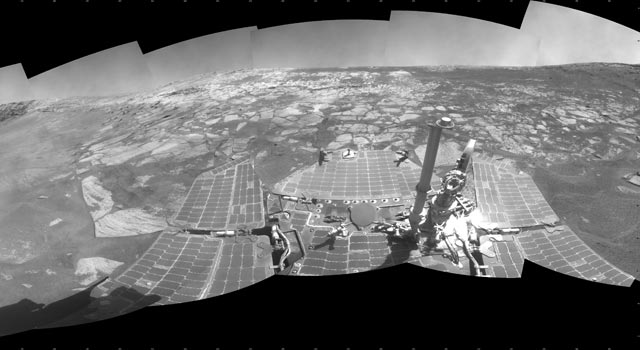Opportunity's two-year exploration of Victoria Crater – a half-mile wide and 250 feet deep – yielded a treasury of information about the planet's geologic history and supported previous findings indicating that water once flowed on the planet's surface, according to Steve Squyres, Cornell professor of astronomy and the principal investigator for NASA's Mars Exploration Rover mission. The rover is now heading south toward Endeavor crater, 8.5 miles away.
Many of those observations – of hematite spheres ("blueberries"), sulfate-rich sandstone and small chunks of rock containing kamacite, troilite and other minerals commonly found in meteorites – are consistent with Opportunity's findings across Meridiani Planum. "It shows that the processes that we investigated in detail for the first time at Endurance crater [where Opportunity spent six months in 2004] are regional in scale, [indicating that] the kinds of conclusions that we first reached at Endurance apply perhaps across Meridiani," said Squyres.

Opportunity’s view at Victoria Crater in February 2009. Image Credit: NASA/JPL-Caltech
Still, there are a few key differences. The rim of Victoria Crater is about 30m higher than the rim of Endurance, said Squyres; and as the rover drove south toward Victoria the hematite blueberries in the soil became ever fewer and smaller. Rocks deep inside the crater, however, contained big blueberries – indicating that the rocks higher up had less interaction with water – and thus the water's source was likely underground.
Detailed analysis of the Victoria data will occupy researchers for years to come, said Jim Bell, professor of astronomy and leader of the mission's Pancam color camera team.
Instruments on the rover's arm studied the composition and detailed texture of rocks just outside the crater and exposed layers in one alcove called "Duck Bay." Rocks found beside the crater include pieces of a meteorite, which may have been part of the impacting space rock that made the crater.
Inside Duck Bay, the rover found that, in some ways, the lower layers differ from overlying ones. The lower layers showed less sulfur and iron, more aluminum and silicon. This composition matches patterns Opportunity found earlier at the smaller Endurance Crater, about 6 kilometers (4 miles) away from Victoria, indicating the processes that varied the environmental conditions recorded in the rocks were regional, not just local.
Meanwhile, on the other side of the planet in Gusev crater, Opportunity's twin rover Spirit caused consternation with an unexplained computer reboot in April. That problem hasn't recurred, but the rover is now stuck, possibly belly-deep, in a patch of fine Martian soil.
"The vehicle seems to be in a unique combination of soft, sandy material and slopes that we haven't encountered yet," said Bell. "Neither one has been particularly problematic in the past, but the combination of the two has us bogged down."
In 2005 Opportunity faced a similar quandary when it found itself mired down for a month in a sand trap named Purgatory Dune.
"We're not calling this purgatory for Spirit yet, but it has that potential," Bell said. Rover team members – including Cornell senior research associate Rob Sullivan, who played a leading role in freeing Opportunity from Purgatory Dune – are using data from the rover and from NASA's Mars Odyssey orbiter and Mars Reconnaissance Orbiter to plan Spirit's escape.
Opportunity, for its part, remains healthy after nearly 1900 sols (Martian days) on the planet – more than 1800 sols beyond its projected lifespan.
"We're living on borrowed time," Squyres said of both rovers. "But we're pushing onward as hard as we can."






Comments